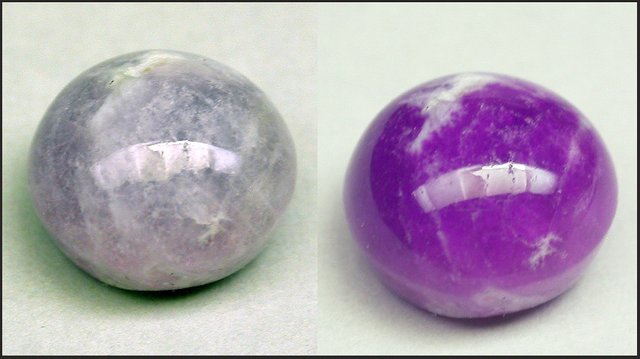
Hackmenite (Afghan variety) presents photochromism when irradiated with ultraviolet light (orange tones); the blue tones are, mostly, wunchite. Source: Wikimedia Commons
All in all, an ultraviolet radiation detector is very useful. In fact, today it is commonly used in photochromic glasses, those that change color by giving them ultraviolet radiation. The problem is that this effect is achieved by the presence of organic molecules, which change their chemical configuration when exposed to radiation; These changes end up accumulating failures that, after a few years, stop working properly.

Tenebrescence in a hakmenite cabochon of gemological quality. Source
Sodalite is a navy blue tectosilicate used in jewelry. A variant of the sodalite is the Hakmanite which, depending on the variety, has photochromism or the opposite property, the so-called tenebrescence, that is, it has a color in the absence of ultraviolet radiation, which disappears if it receives radiation.
A team of researchers headed by Isabella Norrbo, from the University of Turku (Finland), has developed a synthetic Hakmanite that changes color depending on the amount of ultraviolet radiation it receives. The material can be adjusted to respond to different levels of UVA, UVB or UVC radiation, as well as to the UV index of the Sun.
As the color change of the Hakmenite is not due to a change in the chemical composition but to the electronic configuration, the durability is much greater than in the organic alternatives. For this reason the color change is reversible. The nature of the components (silicates) makes the sensor also very cheap to manufacture.
The color intensity of the material correlates with the radiation dose. The detector could be used as a sticker that can be placed on a shirt, a cap or a watch. It would be enough to use an app to measure the status just before going outside taking a photo and the same app will tell us the level of exposure at any later time by making a new photo.
The utility and the health benefits are undoubted. That does not mean that they are the same ones who do not drink before driving or who do not smoke the ones that are most useful to them.
Reference:
I. Norrbo et al (2018) Solar UV index and UV dose determination with photochromic hackmanites: from the assessment of the fundamental properties to the device Materials Horizons doi: 10.1039/C8MH00308D

This post has received a 11.75% upvote from @msp-bidbot thanks to: @mofeta. Delegate SP to this public bot and get paid daily: 50SP, 100SP, 250SP, 500SP, 1000SP, 5000SP Don't delegate so much that you have less than 50SP left on your account.
Downvoting a post can decrease pending rewards and make it less visible. Common reasons:
Submit
Release the Kraken! You got a 7.47% upvote from @seakraken courtesy of @mofeta!
Downvoting a post can decrease pending rewards and make it less visible. Common reasons:
Submit
This post has received a $20.00 % upvote from @siditech thanks to: @mofeta.
Here's a banana!
Downvoting a post can decrease pending rewards and make it less visible. Common reasons:
Submit
This post has received a 2.25 % upvote from @boomerang.
Downvoting a post can decrease pending rewards and make it less visible. Common reasons:
Submit
Your Post Has Been Featured on @Resteemable!
Feature any Steemit post using resteemit.com!
How It Works:
1. Take Any Steemit URL
2. Erase
https://3. Type
reGet Featured Instantly & Featured Posts are voted every 2.4hrs
Join the Curation Team Here | Vote Resteemable for Witness
Downvoting a post can decrease pending rewards and make it less visible. Common reasons:
Submit